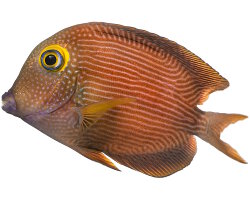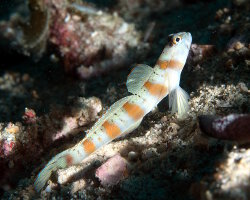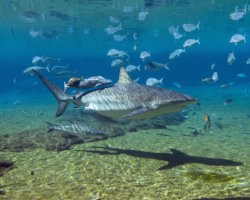Sealife guideExplore the diversity and secrets of bony fish in our oceansMarine vertebrates
Last updated on 08/13/2025 at 11:50 PM
Classification
The class of Osteichthyans includes all fish that have a bony skeleton, as opposed to fish with a cartilaginous skeleton, such as sharks and rays.
The class of Osteichthyans is divided into several subclasses. The most prominent is the Actinopterygians, which includes ray-finned fish. The other subclasses include fossil species as well as a few living species, such as the coelacanth, which lives at great depths.
Description

Anatomy of bony fish
To move through water and navigate in all directions, fish have a variety of fins, some of which appear in pairs on either side of the body. Each position has a specific fin name:
- The caudal fin, more commonly called the tail, is symmetrical in shape and provides most of the propulsion for the fish to move at high speed.
- The pectoral fins appear in pairs on either side of the fish's body. They are primarily used for maneuvering.
- The pelvic fins, also called ventral fins, appear in pairs on the underside of the fish's body.
- The dorsal fins, which can number one or two depending on the species, are located along the dorsal side of the fish. They help stabilize the fish in the water.
- The anal fin is located on the ventral side of the fish's body just behind the anus. Opposite to the dorsal fins, it serves a similar stabilizing function.
Fish have a respiratory system made up of gills through which water flows. Water enters through the mouth and exits behind the head on either side of the body through a single gill slit, called a gill opening.
Diet
Fish are mainly carnivorous, but some species are herbivorous or even sponge-eating.
Observation tips
Fish perceive their environment visually through their eyes. But be aware, they can also detect waves traveling through the water using their lateral line, which runs along the length of their body. This means your presence might be detected before you even enter their field of view! To approach fish, position yourself as far downstream as possible.
Did you know ?
The sailfish is the fastest fish in the world, reaching speeds of about 68 mph, closely followed by the swordfish.
Discover bony fish

John dory
(Zeus faber)
(Zeus faber)

Kole tang
(Ctenochaetus strigosus)
(Ctenochaetus strigosus)

Porkfish
(Anisotremus virginicus)
(Anisotremus virginicus)

Redmargin shrimpgoby
(Amblyeleotris rubrimarginata)
(Amblyeleotris rubrimarginata)

Royal dottyback
(Pictichromis paccagnellorum)
(Pictichromis paccagnellorum)

Spotgill cardinalfish
(Ostorhinchus chrysopomus)
(Ostorhinchus chrysopomus)

Spotted drum
(Equetus punctatus)
(Equetus punctatus)

Squirrelfish
(Holocentrus adscensionis)
(Holocentrus adscensionis)
Our latestUpdates

Friday, December 19th 2025
The magic of Christmas decorations
Discover Christmas decorations in Florida: giant trees, illuminated palm trees, magical light displays and tropical settings to experience the holiday magic under the sun.

Monday, December 15th 2025
The dusky shark
Discover the dusky shark, one of the world's largest coastal sharks, and learn why this powerful predator is essential to marine ecosystems.

Friday, December 12th 2025
Christmas magic at Disney hotels
Experience the magic of Christmas at Disney hotels: enchanting decorations, giant Christmas trees, dazzling lights and a festive holiday atmosphere.
Photo of the Day

Poisson pégase
(Eurypegasus draconis)
(Eurypegasus draconis)
